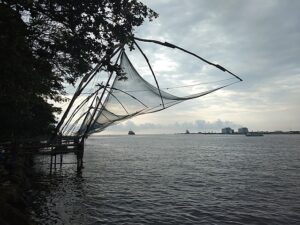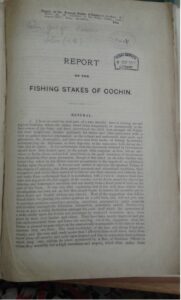by Dr. Devika Shankar (University of Hong Kong)
Across the world, the expansion of port infrastructure in the late 19th and early 20th centuries was accompanied by the marginalization of other economic activities, including fishing. In southwestern India, the clash between the needs of fishing and shipping was especially acute because of the regular use of fishing stakes by local communities.
Fishing with stakes involved tying nets to pairs of stakes that were planted in the beds of various water bodies. As shipping traffic increased during this period, many British officials saw these stakes as impediments to the free movement of people and commodities around the region’s port cities. Growing pressure from shipping interests especially from Bombay, the region’s most significant port, had prompted the government to pass the obstruction to fairways act in 1881 in order to restrict the use of stakes around harbours. Throughout the late 19th century, the colonial administration would continue to use a variety of means to further restrict the placement of stakes in the region, but while conducting research on a harbour development project in Cochin, another important port in southwestern India where the use of stakes was common, I realised that the regulation of fishing stakes was not always a simple matter. It could and did sometimes generate serious legal complications, and raise fundamental questions about the status of water in law.
The Cochin harbour is located in an extremely dynamic and fluid coastline. Today a row of Chinese fishing nets serves as one of its most recognisable features reminding us of the dual role the harbour has played for much of its history.
The harbour has on the one hand served as a refuge for ships on the commercially dynamic Malabar coast while remaining a fertile fishing ground for the region’s numerous fishing communities. As traffic around the harbour increased following the opening of the Suez canal, however, these stakes began to be increasingly seen as hazards leading to calls for their removal. But what made the regulation of these stakes especially complicated in Cochin was that part of the estuary was not within British India, belonging instead to a neighbouring princely state that was also called Cochin.
British officials frequently complained about the problems posed by these stakes that were largely planted by the princely state’s subjects. On one occasion, the port’s collector was even driven to prepare a long list of accidents caused by these stakes after an embarrassing episode in which guests returning from his house following a dinner party had fallen into the backwater when their boat had collided with a row of stakes in the dark. The Cochin State, which coveted the revenues from fishing, however, continued to resist colonial efforts to regulate these stakes as much as possible. One of the ways in which it did so was to emphasize the distinct legal status enjoyed by stakes in Cochin. The state insisted that unlike in British India where flowing waters were placed beyond the bounds of property, in Cochin water between stakes was treated as land. The removal of these stakes could as a result give rise to significant legal complications over private rights and compensation.
This fundamental difference was highlighted in an important report published by the Cochin State on its fisheries in the early 20th century written by Abraham B. Salem.
It was this report, which I had first encountered at the Kerala State Archives at Kochi and then again at the British Library, that had caught my attention while I was conducting research on the development of the Cochin port in the late 19th and 20th centuries. What did it mean to treat water as land and how did this difference between the British and Cochin State approach to water play out in legal disputes relating to the placement of fishing stakes around the port? These were the questions that I had originally sought to answer when I started looking more closely at fishing disputes along India’s south western coastline. As I began to find an increasing number of such disputes from within British India, however, I began to realize that the author of the Cochin State’s fisheries report had in fact erred in assuming that tidal waters could not be considered as property in British India. Over the preceding decades, legal judgments and colonial legislation had in fact paved the way for the extraordinary expansion of private property rights over public and common waters in India. In a recently published article I shed light on these developments and examine how this process unfolded.
I do this through a close analysis of over 10 important and highly cited cases from different parts of British India in which judges deliberated on whether flowing water and fish could be treated as private property. Starting with a significant set of cases relating to the planting of stakes in the sea off the coast of Bombay, the article then primarily looks at cases involving rights over rivers in the fluid landscape of the Bengal delta. The article not only highlights the enduring confusion surrounding the status of water in colonial Indian law, but also looks at the different ways in which judges interpreted roman law and precedents from English common law while reaching their judgments. After reaching a variety of conclusions, by the 1880s high courts had begun to simultaneously make room for unprecedented private rights over flowing waters in colonial India while rendering these rights largely redundant by insisting that fish in these waters could not be counted as property until they were caught. The conflicting pull of these judgments however began to create serious problems in Bengal where fishing rights were considered to be especially valuable. It was in order to overcome this impasse that the Bengal government ultimately passed the Bengal Private Fisheries Protection Act in 1889 granting landholders significant rights over fish in rivers across the province. It would do so by significantly strengthening the kinds of private rights that could be claimed over water, and inaugurating a novel category of “private waters” in tidal waters in Bengal and other parts of India. By tracing the arguments and logics that ultimately paved the way for this act, this article highlights the importance of recognizing colonial India, and especially Bengal as an significant site for experimentation with new forms of private property rights over flowing waters.



